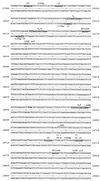Cooperativity between KorB and TrbA repressors of broad-host-range plasmid RK2
- PMID: 11208801
- PMCID: PMC94970
- DOI: 10.1128/JB.183.3.1022-1031.2001
Cooperativity between KorB and TrbA repressors of broad-host-range plasmid RK2
Abstract
The KorB and TrbA proteins of broad-host-range plasmid RK2 are key regulators of the plasmid genes required for conjugative transfer. trbBp is the primary promoter responsible for expression of mating pair formation genes. We show that despite the targets for KorB and TrbA at trbBp being about 165 bp apart, 189 bp upstream of the transcription start point and overlapping the -10 region, respectively, these two proteins show up to 10-fold cooperativity for the repression of trbBp. Deletion analysis of TrbA showed that the C-terminal domain (CTD), which has a high degree of sequence conservation with the CTD of KorA, is required for this cooperativity with KorB. Western blotting demonstrated that the apparently mutual enhancement of repression is not due simply to elevation of repressor level by the presence of the second protein, suggesting that the basis for cooperativity is interaction between KorB and TrbA bound at their respective operators.
Figures






Similar articles
-
Flexibility in repression and cooperativity by KorB of broad host range IncP-1 plasmid RK2.J Mol Biol. 2005 Jun 3;349(2):302-16. doi: 10.1016/j.jmb.2005.03.062. Epub 2005 Apr 8. J Mol Biol. 2005. PMID: 15890197
-
Dissection of the switch between genes for replication and transfer of promiscuous plasmid RK2: basis of the dominance of trfAp over trbAp and specificity for KorA in controlling the switch.J Mol Biol. 1997 Feb 7;265(5):507-18. doi: 10.1006/jmbi.1996.0747. J Mol Biol. 1997. PMID: 9048945
-
Conserved C-terminal region of global repressor KorA of broad-host-range plasmid RK2 is required for co-operativity between KorA and a second RK2 global regulator, KorB.J Mol Biol. 1999 Jun 4;289(2):211-21. doi: 10.1006/jmbi.1999.2761. J Mol Biol. 1999. PMID: 10366500
-
A small protein-protein interaction domain common to KlcB and global regulators KorA and TrbA of promiscuous IncP plasmids.J Mol Biol. 2001 Jun 29;310(1):51-67. doi: 10.1006/jmbi.2001.4729. J Mol Biol. 2001. PMID: 11419936
-
Some repressors of bacterial transcription.Curr Opin Microbiol. 1998 Apr;1(2):145-51. doi: 10.1016/s1369-5274(98)80004-0. Curr Opin Microbiol. 1998. PMID: 10066473 Review.
Cited by
-
Order and disorder in the domain organization of the plasmid partition protein KorB.J Biol Chem. 2010 May 14;285(20):15440-15449. doi: 10.1074/jbc.M109.096099. Epub 2010 Mar 3. J Biol Chem. 2010. PMID: 20200158 Free PMC article.
-
Evolution of a Plasmid Regulatory Circuit Ameliorates Plasmid Fitness Cost.Mol Biol Evol. 2025 Apr 1;42(4):msaf062. doi: 10.1093/molbev/msaf062. Mol Biol Evol. 2025. PMID: 40138356 Free PMC article.
-
Region-specific insertion of transposons in combination with selection for high plasmid transferability and stability accounts for the structural similarity of IncP-1 plasmids.J Bacteriol. 2007 Apr;189(8):3091-8. doi: 10.1128/JB.01906-06. Epub 2007 Feb 2. J Bacteriol. 2007. PMID: 17277066 Free PMC article.
-
Subinhibitory Concentration of Colistin Promotes the Conjugation Frequencies of Mcr-1- and blaNDM-5-Positive Plasmids.Microbiol Spectr. 2022 Apr 27;10(2):e0216021. doi: 10.1128/spectrum.02160-21. Epub 2022 Mar 1. Microbiol Spectr. 2022. PMID: 35230128 Free PMC article.
-
Factors and Mechanisms Influencing Conjugation In Vivo in the Gastrointestinal Tract Environment: A Review.Int J Mol Sci. 2023 Mar 21;24(6):5919. doi: 10.3390/ijms24065919. Int J Mol Sci. 2023. PMID: 36982992 Free PMC article. Review.
References
-
- Gornall A G, Bardawill C J, David M M. Determination of serum proteins by means of the biuret reaction. J Biol Chem. 1949;177:751–766. - PubMed
-
- Jagura-Burdzy G, Thomas C M. Purification of KorA protein from broad host range plasmid RK2: definition of a hierarchy of KorA operators. J Mol Biol. 1995;253:39–50. - PubMed
Publication types
MeSH terms
Substances
LinkOut - more resources
Full Text Sources

